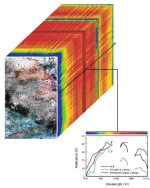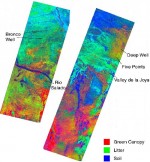Imaging Spectroscopy Focuses on Jornada and Sevilleta LTER Sites
Greg Asner, Department of Geological Sciences and Environmental Studies, University of Colorado
For the past several years, a unique form of remote sensing called imaging spectroscopy has been taking place in the skies above the Jornada and Sevilleta LTER sites in New Mexico. Imaging spectroscopy is unique because the recorded data contain the full solar reflected spectrum of the imaged landscape (Figure 1). This complete spectrum can provide information about vegetation and soil properties not obtainable from traditional multispectral remote sensing instruments, such as Landsat, which collect data in a few broad regions of the spectrum. For example Landsat measures six separate spectral bands while the hyperspectral sensor measures in more than 200 contiguous spectral bands. The full spectral coverage enables spectroscopy analysis based in physics, chemistry, and biology, which is not possible with the multispectral approach. Our efforts are underway to advance and improve the interpretation of spectral signatures of arid and semi-arid ecosystems, which in turn will greatly improve our ability to assess climate and land-use impacts in these regions.
NASA’s premier imaging spectrometer called the Airborne Visible and Infrared Imaging Spectrometer (AVIRIS) has been tasked to collect hyperspectral data over the Jornada and Sevilleta. During these AVIRIS overflights, field campaigns have been coordinated to collect spatial information on vegetation and soil properties. These data sets are providing us with the means to develop new approaches for estimating ecologically important variables such as vegetation and bare soil extent, leaf area index, standing litter quantities, water stress, and vegetation phenology (Figure 2). These biophysical and ecological quantities are then used in models of biogeochemistry, physiology, fire fuel loading, and grazing intensity. Our methods to extract this biophysical information from the AVIRIS imagery include spectral signature deconvolution and radiative transfer models, but they require intensive computer resources. My lab has a high-performance Beowulf computing cluster based on the original design developed at NASA’s Goddard Space Flight Center. We are working with NASA’s AVIRIS team (Jet Propulsion Laboratory, Pasadena, CA) and Jornada and Sevilleta LTER investigators to provide an efficient processing, analysis and validation effort that could eventually support detailed regional scale ecological studies at the two sites.
While the AVIRIS effort continues, our group is preparing for the launch into Earth orbit of the first spaceborne imaging spectrometer, which is scheduled for this summer. Part of NASA’s New Millenium Program, the Earth Observing-1 (EO-1) satellite is a technology demonstration, and it will carry the Hyperion instrument to collect hyperspectral data over a select number of test sites including the Jornada and Sevilleta. If successful, Hyperion will represent a true milestone in demonstrating new Earth remote sensing technology, hopefully paving the way toward the next generation of high performance globally available imaging spectrometer measurements.
I believe that this technology will revolutionize our ability to remotely measure vegetation, soil and other Earth properties with unparalleled physical and chemical detail. For us, the Jornada and Sevilleta LTER sites will continue to be a major focus of research toward this goal.
For more information on this project, please contact:
- Greg Asner, Department of Geological Sciences and Environmental Studies Program University of Colorado, Boulder, CO
- Robert Green, NASA AVIRIS Program Jet Propulsion Laboratory, California Institute of Technology, Pasadena, CA
- Barbara Nolen, Jornada LTER, Las Cruces, NM
- Greg Shore, Sevilleta LTER, Department of Biology, University of New Mexico Albuquerque, NM
- Carol Wessman, Department of EPO Biology and CIRES, University of Colorado, Boulder, CO

 Enlarge this image
Enlarge this image
